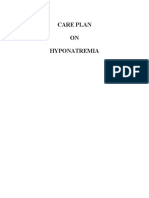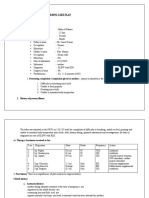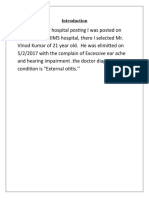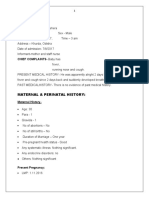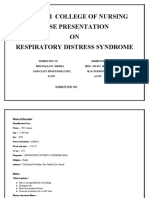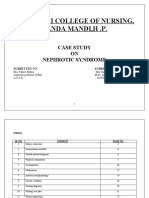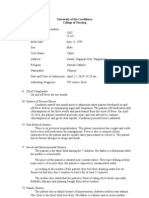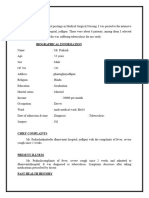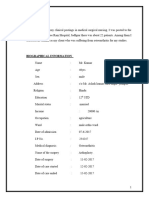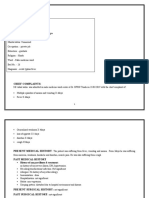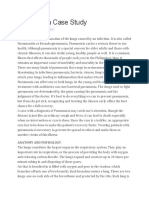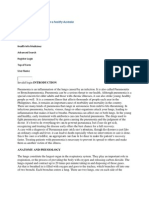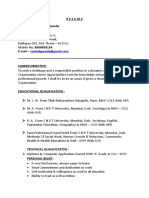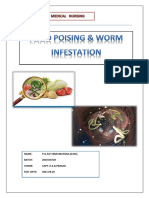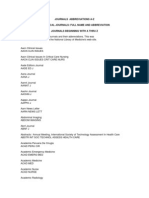Case Study Pneumonia
Case Study Pneumonia
Uploaded by
Fretzie Mae RamasCopyright:
Available Formats
Case Study Pneumonia
Case Study Pneumonia
Uploaded by
Fretzie Mae RamasCopyright
Available Formats
Share this document
Did you find this document useful?
Is this content inappropriate?
Copyright:
Available Formats
Case Study Pneumonia
Case Study Pneumonia
Uploaded by
Fretzie Mae RamasCopyright:
Available Formats
CASE STUDY ON PNEUMONIA
OBJECTIVES Define what is Pneumonia Trace the Pathophysiology of Pneumonia Enumerate the different signs and symptoms of pneumonia Formulate the different signs and symptoms of pneumonia Formulate and nursing care plans utilizing the nursing process To learn new clinical skills as well as sharpen once current clinical skills required in the management of the patient of pneumonia To develop our sense of unselfish love and empathy in rendering nursing care plan to our patient so that we may be able to serve future clients with higher level of holistic understanding as well as individual care
INTRODUCTION Pneumonia is an inflammation of the lungs caused by an infection. It is also called Pneumonitis or Bronchopneumonia. Pneumonia can be a serious threat to our health. Although pneumonia is a special concern for older adults and those with chronic illnesses, it can also strike young, healthy people as well. It is a common illness that affects thousands of people each year in the Philippines, thus, it remains an important cause of morbidity and mortality in the country. There are many kinds of pneumonia that range in seriousness from mild to lifethreatening. In infectious pneumonia, bacteria, viruses, fungi or other organisms attack your lungs, leading to inflammation that makes it hard to breathe. Pneumonia can affect one or both lungs. In the young and healthy, early treatment with antibiotics can cure bacterial pneumonia. The drugs used to fight pneumonia are determined by the germ causing the pneumonia and the judgment of the doctor. Its best to do everything we can to prevent pneumonia, but if one do get sick, recognizing and treating the disease early offers the best chance for a full recovery. A case with a diagnosis of Pneumonia may catch ones attention, though the disease is just like an ordinary cough and fever, it can lead to death especially when no intervention or care is done. Since the case is a toddler, an appropriate care has to be done to make the patients recovery faster. Treating patients with pneumonia is necessary to prevent its spread to others and make them as another victim of this illness. PATIENTS HISTORY a. Patients Profile Name: R.C.S.B. Age: 1 yr,1 mo. Weight:10 kgs Religion: Roman Catholic Mother: C.B. Address: Cebu City Father: D.B Address: California, USA b. Chief Complaint: Fever Date of Admission: 1st admission Hospital Number: 060000086199 c. History of Present Illness 2 days PTA (+) cough (+) nasal congestion, watery to greenish (+) nasal discharge Tx: Disudrin OD Loviscol OD Few hrs PTA - (+) fever, Tmax= 39.3 C (+) difficulty of breathing (+) vomiting, 1 episode
Tx: Paracetamol Sought consultation at ER: Rx=BPN, Salbutamol neb. IE: T = 38.3C, CR= 122s, RR= 73s (+) TPC SCE, (-) retractions, clear BS, (-) cyanosis, (-) edema d. Past Illness (-) asthma (-) allergies e. Family History PMHx: (-) Asthma (+) smoke (grandfather) fathers side (+) smoke (father) (+) diabetes (grandmother) fathers side f. Activities of Daily Living Sleeping mostly at night and during afternoon Usually wakes up early in the morning (5AM) to be milkfed. Eats a lot (hotdogs, chicken, crackers, any food given to her) Active, responsive BM (1-2 times a day) Urinates in her diaper (more than 4 times a day) Likes to play with those around her g. Review of Systems Neuromuscular: weakness of muscles Integumentary: (-) cyanosis Respiratory: tachypnea; (+) DOB; (+) coarse crackles, (+) wheezes, Digestive: food aversion, vomits ingested milk
GORDONS FUNCTIONAL PATTERN Before Hospitalization Patient eat her meals 3 times a day in almost of her mothers meal. Commonly she drinks milk and During Hospitalization She only drink formulated milk 3 times a day in small bottle. Interpretation There are big differences in her nutrition before and during hospitalization, she loss her appetite in almost
NUTRITION
eat rice.
ELIMINATION
Normally, consumes 4 diapers daily.
EXERCISE
She is active and has long period of playing.
REST AND SLEEP
She was able to consume 8 hours of sleeping normally. She had a schedule for naps, twice a day.
75%. Patients who are hospitalized may have an inadequate dietary intake because of the illness that necesitated the hospitalization or the hospitals food is unfamiliar. She consumes only 2 The consumption diapers. of diapers before and during hospitalization was decreased. Decrease elimination is due to decrease food intake. Her play is limited. She Before she is doesnt move too much. active but her move during confinement becomes limited. Decreased activity is because of the intravenous fluid attach to her thus limiting her movement to prevent the intravenous line to get tangle to her. Patient takes a nap 20 to Before 30 minutes a day and hospitalization, she sleeps 3-4 hours she had a normal only. normal sleep pattern but during hospitalization he had abnormal sleep pattern. Respiratory
HYGIENE
Regularly, she takes a bath early morning with the assistance of her mother.
She never takes a bath. Her mother would do sponge bath for her.
SUBSTANCE USE
Before admission: patient took Disudrin once a day Loviscol once a day
Physician orders the ff: Salbutamol (ventolin) Cefuroxime (Zinacef) Paracetamol
condition can disturb an individual sleep. Shortness of breath often makes sleep difficult. Hospitals environment also affects the sleep. Environmental and lack of ventilation can affect sleep. Before hospitalization, the patient takes a bath regularly. But during confinement, she never takes a bath and thus needs the assistance of her mother for sponge bathing. This is due to environmental setiing. The hospital might not have available facilities for bathing. Medications before and during confinement differed. During confinement, additional or revision of medications happen for it will be based on laboratory findings.
GENOGRAM
No hereditary illness in mothers side. In her fathers side, her father and grandfather are occasional smokers. Her grandmother is dagnosed as diabetic. PATIENTS HEALTH ASSESSMENT General Appearance Posture the patient is crying and irritated when in lying position. Skin color she has whitish skin color. Hygiene sponge bath done by her mother, no unpleasant odor, wears clean clothes. Verbal she wants to be cuddled by her mother and cries when put in bed. Non-verbal the patient is rolling in the bed and grasping anything she saw. VITAL SIGNS Temperature Normal Findings 36.5 37.5 C Actual Findings 38.3 C Interpretation The patient is having fever. Fever is a sign there is something wrong with the body system and her fever is due to her
present illness. 120 160 bpm Cardiac Rate 122 bpm Cardiac rate is within normal range. Shows increased respiratory rate. Patient is experiecning tachypnea.
30 60 cpm
73 cpm
Respiratory Rate
ANATOMY AND PHYSIOLOGY
The lungs constitute the largest organ in the respiratory system. They play an important role in respiration, or the process of providing the body with oxygen and releasing carbon dioxide. The lungs expand and contract up to 20 times per minute taking in and disposing of those gases. Air that is breathed in is filled with oxygen and goes to the trachea, which branches off into one of two bronchi. Each bronchus enters a lung. There are two lungs, one on each side of the breastbone and protected by the ribs. Each lung is made up of lobes, or sections. There are three lobes in the right lung and two lobes in the left one. The lungs are cone shaped and made of elastic, spongy tissue. Within the lungs, the bronchi branch out into minute pathways that go through the lung tissue. The pathways are called bronchioles, and they end at microscopic air sacs called alveoli. The alveoli are surrounded by capillaries and provide oxygen for the blood in these vessels. The oxygenated blood is then pumped by the heart throughout the body. The alveoli also take in carbon dioxide, which is then exhaled from the body. Inhaling is due to contractions of the diaphragm and of muscles between the ribs. Exhaling results from relaxation of those muscles. Each lung is surrounded by a two-layered membrane, or the pleura, that under normal circumstances has a very, very small amount of fluid between the layers. The fluid allows the membranes to easily slide over each other during breathing.
PATHOPHYSIOLOGY
Pneumonia is a serious infection or inflammation of your lungs. The air sacs in the lungs fill with pus and other liquid. Oxygen has trouble reaching your blood. If there is too little oxygen in your blood, your body cells cant work properly. Because of this and spreading infection through the body pneumonia can cause death. Pneumonia affects your lungs in two ways. Lobar pneumonia affects a section (lobe) of a lung. Bronchial pneumonia (or bronchopneumonia) affects patches throughout both lungs. Bacteria are the most common cause of pneumonia. Of these, Streptococcus pneumoniae is the most common. Other pathogens include anaerobic bacteria, Staphylococcus aureus, Haemophilus influenzae, Chlamydia pneumoniae, C. psittaci, C. trachomatis, Moraxella (Branhamella) catarrhalis, Legionella pneumophila, Klebsiella pneumoniae, and other gram-negative bacilli. Major pulmonary pathogens in infants and children are viruses: respiratory syncytial virus, parainfluenza virus, and influenza A and B viruses. Among other agents are higher bacteria including Nocardia and Actinomyces sp; mycobacteria, including Mycobacterium tuberculosis and atypical strains; fungi, including
Histoplasma capsulatum, Coccidioides immitis, Blastomyces dermatitidis, Cryptococcus neoformans, Aspergillus fumigatus, and Pneumocystis carinii; and rickettsiae, primarily Coxiella burnetii (Q fever). The usual mechanisms of spread are inhaling droplets small enough to reach the alveoli and aspirating secretions from the upper airways. Other means include hematogenous or lymphatic dissemination and direct spread from contiguous infections. Predisposing factors include upper respiratory viral infections, alcoholism, institutionalization, cigarette smoking, heart failure,chronic obstructive airway disease, age extremes, debility, immunocompromise (as in diabetes mellitus and chronic renal failure), compromised consciousness, dysphagia, and exposure to transmissible agents. Typical symptoms include cough, fever, and sputum production, usually developing over days and sometimes accompanied by pleurisy. Physical examination may detect tachypnea and signs of consolidation, such as crackles with bronchial breath sounds. This syndrome is commonly caused by bacteria, such as S. pneumoniae and H. influenzae.
NURSING ACTIONS INDEPENDENT positioning of the patient with head on mid line, with slight flexion rationale: to provide patent, unobstructed airway , maximum lung excursion auscultating patients chest rationale: to monitor for the presence of abnormal breath sounds provide chest and back clapping with vibration rationale: chest physiotheraphy facilitates the loosening of secretions considering that the patient is an infant, and has developed a strong stranger anxiety as manifested by white coat syndrome , it is a nursing action to play with the patient. rationale: to establish rapport, and gain the patients trust DEPENDENT administer due medications as ordered by the physician, bronchodilators, anti pyretics and anti biotics rationale: bronchodilators decrease airway resistance, secondary to bronchoconstriction, anti pyretics alleviate fever, antibiotics fight infection placing patient on TPN prn rationale: to compensate for fluid and nutritional losses during vomiting COLLABORATIVE assist respiratory therapist in performing nebulization of the patient rationale: nebulization is a favourable route of administering bronchodilators and aid in expectorating secretions, hence patients breathing PHYSICIANS ORDER SHEET 11/19/06
Admit patient to CHH under the service of Dr. Vitan secure consent for admission and management, TPR every shift then record. May have diet for age with strict aspiration precaution, IVF D5 0.3NaCl 500cc to run at 62-63mgtts/min.May give paracetamol 125mg 1supp/rectum if oral paracetamol is not tolerated. 11/20/06 For urinalysis, IVF to follow D5 0.3 NaCl 500 at SR (62-63mgtt/m Use zinacef brand of cefuroxime 750mg- given vial 375mg every 8hours, nebulize (Ventolin 1 nebule) every 6 hours, paracetamol drugs prn every 4hours (Temp 37.8). 11/21/06 Continue cefuroxine and nebulizer every 6 hours. May not reinsert IVF, revise Cefuroxime IV to Cefuroxime 500mg via deep Intramuscular BID,continue management. 11/22/06 Continue management and refer.
DISCHARGE PLANNING Take the entire course of any prescribed medications. After a patients temperature returns to normal, medication must be continued according to the doctors instructions, otherwise the pneumonia may recur. Relapses can be far more serious than the first attack. Get plenty of rest. Adequate rest is important to maintain progress toward full recovery and to avoid relapse. Drink lots of fluids, especially water. Liquids will keep patient from becoming dehydrated and help loosen mucus in the lungs. Keep all of follow-up appointments. Even though the patient feels better, his lungs may still be infected. Its important to have the doctor monitor his progress. Encourage the guardians to wash patients hands. The hands come in daily contact with germs that can cause pneumonia. These germs enter ones body when he touch his eyes or rub his nose. Washing hands thoroughly and often can help reduce the risk. Tell guardians to avoid exposing the patient to an environment with too much pollution (e.g. smoke). Smoking damages ones lungs natural defenses against respiratory infections. Give supportive treatment. Proper diet and oxygen to increase oxygen in the blood when needed.
Protect others from infection. Try to stay away from anyone with a compromised immune system. When that isnt possible, a person can help protect others by wearing a face mask and always coughing into a tissue.
You might also like
- Prioritization Delegation and Assignment PrinciplesDocument1 pagePrioritization Delegation and Assignment PrinciplesPaola Agustin0% (1)
- Case ScenarioDocument2 pagesCase ScenarioMARIA ANGELIKA DEL ROSARIONo ratings yet
- Nursing Care Plan On Day - 1: Identification DataDocument26 pagesNursing Care Plan On Day - 1: Identification DataManisa ParidaNo ratings yet
- Case Study On Jaundice-1Document30 pagesCase Study On Jaundice-1kamini ChoudharyNo ratings yet
- Case Study On MalariaDocument18 pagesCase Study On MalariaRameshKrishnanNo ratings yet
- Case Presentation: Paediatrics: by Tapan Jyoti Saikia 8 Sem Gauhati Medical CollegeDocument22 pagesCase Presentation: Paediatrics: by Tapan Jyoti Saikia 8 Sem Gauhati Medical CollegeArpit Mehta100% (1)
- Case Study On Angina PectorisDocument4 pagesCase Study On Angina Pectorismahi0% (1)
- Case StudyDocument29 pagesCase StudyGerome ValderamaNo ratings yet
- Case Presentation On Pharyngitis2Document10 pagesCase Presentation On Pharyngitis2kamini ChoudharyNo ratings yet
- Case Study On BronchitisDocument19 pagesCase Study On BronchitisSuchitaNo ratings yet
- Case Study Brochitis (GORON)Document14 pagesCase Study Brochitis (GORON)CJ GoronNo ratings yet
- Case Study HypertnsionDocument32 pagesCase Study HypertnsionAnkush Kulat Patil100% (1)
- Case Report Acute Otitis MediaDocument28 pagesCase Report Acute Otitis Mediamayo djitro100% (2)
- Broncho Pnuemonia MEDICALDocument9 pagesBroncho Pnuemonia MEDICALArchana SahuNo ratings yet
- DiarrhoeaDocument23 pagesDiarrhoeaPrepladder MedicineNo ratings yet
- CARE PLAN On HyponatremiaDocument35 pagesCARE PLAN On Hyponatremia2020 MSc bhuvaneswari 05100% (1)
- Care Plan: Patient' S BiodataDocument11 pagesCare Plan: Patient' S BiodataAnonymous xoEdtD91% (35)
- Anatomy &physiology JaundiceDocument2 pagesAnatomy &physiology JaundiceHCX dghhqNo ratings yet
- A Case Presentation On PneumoniaDocument74 pagesA Case Presentation On PneumoniaYengkhom YoshiNo ratings yet
- Nursing Care PlanDocument21 pagesNursing Care PlanMeena KoushalNo ratings yet
- Enteric FeverDocument30 pagesEnteric FeverShivam MalikNo ratings yet
- CASE STUDY ON CholelithiasisDocument20 pagesCASE STUDY ON CholelithiasisSimran ChauhanNo ratings yet
- Care Plan-OtitisDocument33 pagesCare Plan-OtitisSunil KumarNo ratings yet
- Case Presentation On CVTDocument32 pagesCase Presentation On CVTraman kumari100% (1)
- Case Study On Anemia PDFDocument31 pagesCase Study On Anemia PDFDrPreeti Thakur ChouhanNo ratings yet
- Case Presentation RVFDocument15 pagesCase Presentation RVFMeena Koushal100% (1)
- Case Presentation TofDocument32 pagesCase Presentation TofISLAMIC KNOWLEDGE BASED ON TRULY HADIS100% (2)
- Surgical CP ParotidDocument43 pagesSurgical CP ParotidValarmathiNo ratings yet
- Case Study On HEAD INJURYDocument11 pagesCase Study On HEAD INJURYanimesh pandaNo ratings yet
- Pediatic Case Presentation FinalDocument26 pagesPediatic Case Presentation FinalJyoti Prem Uttam100% (1)
- PP Insect Bite 2007 (Print)Document16 pagesPP Insect Bite 2007 (Print)Ali RumiNo ratings yet
- Care Plan On Nephrotic SyndromeDocument31 pagesCare Plan On Nephrotic Syndromepriyanka bhavsar100% (1)
- Case Presentation 2Document53 pagesCase Presentation 2Hussain AzharNo ratings yet
- Health Education On HypertentionDocument13 pagesHealth Education On HypertentionParth VasaveNo ratings yet
- Case Study: Acute BronchitisDocument34 pagesCase Study: Acute BronchitisJeffany Anne Rabaya Retirado0% (1)
- Case Presentation Meningitis 1Document17 pagesCase Presentation Meningitis 1chaudharitrushar007No ratings yet
- Case Study BronchiolitisDocument15 pagesCase Study Bronchiolitisanimesh panda0% (1)
- Case Presentation Acute Abdomen PediatricDocument17 pagesCase Presentation Acute Abdomen PediatricDevina TandiasNo ratings yet
- Rds CPDocument31 pagesRds CPSwati Sharma50% (2)
- Case Presentation OF: Iron Deficiency AnemiaDocument33 pagesCase Presentation OF: Iron Deficiency Anemiaitshurt_teardrops100% (1)
- Cagayan State University: Pediatrics 2 LaboratoryDocument12 pagesCagayan State University: Pediatrics 2 LaboratoryAmaetenNo ratings yet
- Meconium Aspiration SyndromeDocument17 pagesMeconium Aspiration Syndromeashishpandey.ap8435No ratings yet
- Nephrotic SyndromeDocument38 pagesNephrotic SyndromeSwati SharmaNo ratings yet
- Care Plan On: Submitted To: Submitted byDocument38 pagesCare Plan On: Submitted To: Submitted byMoonNo ratings yet
- History Collection and Physical Examination Kardex Nurses Notes PDFDocument53 pagesHistory Collection and Physical Examination Kardex Nurses Notes PDFSalma SultanaNo ratings yet
- Typhoid Fever 2010Document28 pagesTyphoid Fever 2010Earl John Natividad100% (3)
- Drug StudyDocument10 pagesDrug StudyBandana RajpootNo ratings yet
- Case PresentationDocument31 pagesCase PresentationArsalan NadeemNo ratings yet
- Meddical Care Study Part 1Document48 pagesMeddical Care Study Part 1christyNo ratings yet
- CP On AnginaDocument21 pagesCP On AnginaNavpreet Kaur100% (1)
- Nursing Case Presentation For A Patient With CABG: Subject: Medical Surgical Nursing-IIDocument10 pagesNursing Case Presentation For A Patient With CABG: Subject: Medical Surgical Nursing-IIanamika sharmaNo ratings yet
- NCP On TuberculosisDocument23 pagesNCP On TuberculosisPreeti ChouhanNo ratings yet
- Care Plan On ARTHROPLASTYDocument19 pagesCare Plan On ARTHROPLASTYPreeti ChouhanNo ratings yet
- Case Study On Nephrotic SyndromeDocument7 pagesCase Study On Nephrotic SyndromeArchana VermaNo ratings yet
- Clinical Presentation On AppendicectomyDocument30 pagesClinical Presentation On AppendicectomyValarmathi100% (1)
- TH THDocument29 pagesTH THK RAVI KUMARNo ratings yet
- Case Pres )Document18 pagesCase Pres )Justin Faye VibarNo ratings yet
- Scrub Typhus FeverDocument20 pagesScrub Typhus FeverDimpal ChoudharyNo ratings yet
- Ventricular Septal Defect, A Simple Guide To The Condition, Treatment And Related ConditionsFrom EverandVentricular Septal Defect, A Simple Guide To The Condition, Treatment And Related ConditionsNo ratings yet
- Pneumonia Case StudyDocument5 pagesPneumonia Case StudycrisolandNo ratings yet
- Pneumonia Case StudyDocument8 pagesPneumonia Case StudyChristopher John AgueloNo ratings yet
- Health Info Health Info Medicines Advanced Search Register Login Top of Form User NameDocument24 pagesHealth Info Health Info Medicines Advanced Search Register Login Top of Form User NameAnusha PradhanNo ratings yet
- Report 4 of 3402Document5 pagesReport 4 of 3402Alamin KhanNo ratings yet
- Guide To CDA Services To ViewDocument4 pagesGuide To CDA Services To ViewSheila JuddNo ratings yet
- Welcome To COVID Vaccine Dystopia.Document64 pagesWelcome To COVID Vaccine Dystopia.Joel S. Hirschhorn100% (1)
- Dr. Lisa PPT Burn Injury Revisi OkDocument35 pagesDr. Lisa PPT Burn Injury Revisi OkRsud Malinau Ppk BludNo ratings yet
- OISD-GDN-166-Occupational Health Monitoring IN Oil&Gas IndustryDocument64 pagesOISD-GDN-166-Occupational Health Monitoring IN Oil&Gas IndustrySaravanan PeriyasamyNo ratings yet
- Neeta Resume (1) - 3Document2 pagesNeeta Resume (1) - 3Neeta GawdeNo ratings yet
- Interpreting Medication OrdersDocument11 pagesInterpreting Medication Ordersmedgeek nmeNo ratings yet
- Basic Principle of ChemotherapyDocument29 pagesBasic Principle of ChemotherapyDevby Ulfandi100% (1)
- Food Poisoning & Worm InfestationDocument13 pagesFood Poisoning & Worm InfestationPujani SenevirathnaNo ratings yet
- Skilled Birth Attendant (SBA) and Home Delivery in India: A Geographical StudyDocument8 pagesSkilled Birth Attendant (SBA) and Home Delivery in India: A Geographical StudyInternational Organization of Scientific Research (IOSR)No ratings yet
- EPI Scorecard - Sudan - Q1 - 2018Document1 pageEPI Scorecard - Sudan - Q1 - 2018محمد أبو القاسم عليNo ratings yet
- Rle Rotation RequirementsDocument13 pagesRle Rotation RequirementsMarco CastroNo ratings yet
- Lo Han Guo FruitDocument9 pagesLo Han Guo FruitInten KusumaNo ratings yet
- Comirnaty Epar Risk Management Plan - enDocument114 pagesComirnaty Epar Risk Management Plan - enaumardogNo ratings yet
- Chapter 3 & 4 - Rights, Obligations, Duties and ResponsibiliDocument26 pagesChapter 3 & 4 - Rights, Obligations, Duties and ResponsibiliChalie Mequanent100% (1)
- Sample: Tohfla Teaching VersionDocument6 pagesSample: Tohfla Teaching VersionPredrag PetrovicNo ratings yet
- Nursing Skills ChartingDocument32 pagesNursing Skills Chartingsherry_moser67% (3)
- Encephalitis: - Gunaseelan KumarDocument30 pagesEncephalitis: - Gunaseelan KumarGunaseelan Kumar100% (1)
- Geography Men Who Have Sex With Men SuburbsDocument76 pagesGeography Men Who Have Sex With Men SuburbsTreyNo ratings yet
- Journals Abbreviations A-ZDocument477 pagesJournals Abbreviations A-ZHitesh VermaNo ratings yet
- Endodontic Treatment of Dens InvaginatusDocument7 pagesEndodontic Treatment of Dens InvaginatusParidhi GargNo ratings yet
- Milton Lappin, Detroit, MichDocument10 pagesMilton Lappin, Detroit, MichMarcos CastroNo ratings yet
- Final Aiq Seat Matrix For MD - Ms - Diploma Round 1Document556 pagesFinal Aiq Seat Matrix For MD - Ms - Diploma Round 1garwesfvNo ratings yet
- Godavari College of Nursing, Jalgaon: Daily Clinical Dairy ReportDocument6 pagesGodavari College of Nursing, Jalgaon: Daily Clinical Dairy ReportbuntyNo ratings yet
- The Impact of Drug Abuse On Society A Review On Drug Abuse in The Context of SocietyDocument3 pagesThe Impact of Drug Abuse On Society A Review On Drug Abuse in The Context of SocietyInternational Journal of Innovative Science and Research TechnologyNo ratings yet
- Lidocaine HydrochlorideDocument12 pagesLidocaine HydrochlorideShivam VinothNo ratings yet
- Catch Up Friday - Mapeh - 9 Lesson 1Document5 pagesCatch Up Friday - Mapeh - 9 Lesson 1sharkeniranNo ratings yet
- Cebu Institute of Technology University N. Bacalso Ave., Cebu City Philippines College of Nursing and Allied Health SciencesDocument4 pagesCebu Institute of Technology University N. Bacalso Ave., Cebu City Philippines College of Nursing and Allied Health SciencesMikha BorcesNo ratings yet















